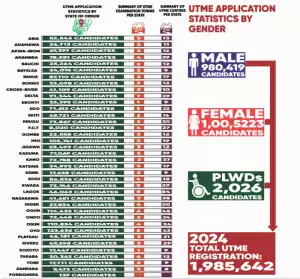JAMB 2016 Official English Language Syllabus And Recommended Texts

JAMB 2016 Official English Language Syllabus And Recommended Texts
The aim of the Unified Tertiary Matriculation Examination (UTME) syllabus in Use of English is to prepare the candidates for the Board’s examination. It is designed to test their achievement of the course objectives, which are to:
(1) communicate effectively in both written and spoken English;
(2) have a sound linguistic basis for learning at the tertiary level. The syllabus consists of two sections:
I. Comprehension/Summary
II. Lexis, Structure and Oral Forms
1. Comprehension/Summary
(a) description
(b) narration
(c) exposition
(d) argumentation/persuasion
(i) Each of the four passages to be set (one will be a cloze test) should reflect various disciplines and be about 400 words long.
(ii) Questions on passages will test the; following:
The general novel to read this year is titled; “The Last Days at Forcados High School” by A.H. Mohammed will test the following:
(a) Comprehension of the whole or part of each passage.
(b) Comprehension of words, phrases, clauses, sentences, figures of speech and idioms as used in the passages.
(c) Coherence and logical reasoning (deductions, inferences, etc)
(d) Synthesis of ideas from the passages.
Candidates should be able to:
i. identify main points in passages;
ii. determine implied meaning;
iii. identify the grammatical functions of words, phrases and clauses and figurative /idiomatic expression;
iv. deduce or infer the writer’s opinion, mood, attitude to the subject matter, etc.
NOTE:
By synthesis of ideas is meant the art of combining distinct or separate pieces of information to form a complex whole, that is, the ability to make generalizations from specific ideas mentioned in the passages. Such generalizations involve identifying the mood or tone of the writer, his attitude to the subject matter, his point of view, etc. In this regard, synthesis is a higher-level skill than summary.
2. Lexis, Structural and Oral Forms
2.1 Lexis and Structure
(a) synonyms
(b) antonyms
(c) homonyms
(d) clause and sentence patterns
(e) word classes and their functions
(f) mood, tense, aspect, number, agreement/concord, degree (positive, comparative and superlative) and question tags
(g) punctuation and spelling
(h) ordinary usage (words in their denotative or dictionary sense), figurative usage (expressions used in ways other than literal) and idiomatic usage (expressions whose meanings cannot be determined through a mere combination of individual words) are to be tested.
NOTE:
Idioms to be tested will be those expressed in standard British English (i.e those with universal acceptability)
2.2 Oral Forms
(a) Vowels (monophthongs and diphthongs
(b) Consonants (including clusters)
(c) Rhymes (homophones)
(d) Stress (word, sentence and emphatic)
(e) Intonation
NOTE:
Sentence stress should not be mistaken for emphatic or contrastive stress. It involves the placement of normal stress on content words (nouns, main verbs, adjectives and adverbs) in an utterance. Here, no emphasis or contrast is intended. For example, the words ‘see’ and ‘soon’ would normally be stressed in the sentence, I’ll see you soon’.
Candidates should be able to:
i. use words and expressions in their ordinary, figurative and idiomatic contexts;
ii. determine similar and opposite meanings;
iii. differentiate between correct and incorrect punctuation and spelling;
iv. identify various grammatical pattern in use;
v. interpret information conveyed in sentences.
Candidates should be able to:
i. distinguish correct from incorrect vowels;
ii. differentiate correct from incorrect consonants;
iii. identify silent letters, vowel length; consonant clusters, etc.
iv. determine appropriate uses of stress in words (monosyllabic, disyllabic and polysyllabie) and in sentences (emphatic/contrastive);
v. detect partial and complete rhymes.
SECTION A: Comprehension/Summary
(a) 3 comprehension passages (15 questions in all, 3 marks each) = 45 marks
(b) I cloze passage (10 questions in all, 2 marks each) = 20 marks
SECTION B: Lexis, Structure and Oral Forms
(a) Sentence interpretation (10 questions in all, 2 marks each) = 20 marks
(b) Antonyms (opposite in meaning -15 questions in all, 1 mark each) = 15 marks
(c) Synonyms (same in meaning – 15 questions in all, 1 mark each) = 15 marks
(d) Sentence completion (filling in the gaps – 20 questions in all, 1 mark each) = 20 marks
(e) Oral forms (15 questions in all, 1 mark each) = 15 marks Total: 100 questions = 150 marks
Bamgbose, A. (2002). English Lexis and Structure for Senior Secondary Schools and colleges (Revised Edition), Ibadan: Heinemann
Banjo, A. name(s)? (2004). New Oxford Secondary English Course Book Six for Senior Secondary Schools, Ibadan: UP Plc.
Banjo, A. Ayodele, S. and Ndahi, K. S. (1997). Exam Focus: English for WASSCE and SSCE, Ibadan UP Plc
Caesar, O. J. (2003). Essential Oral English for Schools and Colleges, Lagos: Tonad Publishers Limited
Egbe, D. I (1996). Mastering English Usage and Communication Skills, Lagos: Tisons
Elugbe, B. (2000). Oral English for Schools and Colleges, Ibadan: Heinemann
Grant, N. J. H, Nnamonu, S. Jowitt, D. (1998). Senior English Project 3, (New Edition) Harlow: Longman
Idowu, O. O, Sogbeson, T. S, Adofo, A. K. Burgess, D. F and Burgess, L. J. (1998). Round-up English: A Complete Guide, Lagos: Longman
Idris, U. (2001). Oral English at Your Fingertips for Schools and Colleges, Lagos, M. Youngbrain Publishers
Igwe, S. O. Atoye, R. O. and Olayiwola, B. A. (2005). JAMB Success: English Language for UME, PCE, Ibadan: UP Plc
Nnamonu, S. and Jowitt, D. (1987) .Use of English: JAMB Practice Tests, Lagos: Longman.
Nnamonu, S. and Jowitt, D. (1989). Common Errors in English, Lagos: Longman
Obinna, M. F. (2001). University Matriculation Use of English,(Fourth Edition) Port Harcourt: Sunray Books Limited
Ogunsanwo, O. Duruaku, A. B.C, Ezechukwu, J and Nwachukwu, U. I (2005). Countdown English Language, (Revised Edition), Ibadan: Evans
Olatoye, S. (2006). The Silent Teacher, Ado-Ekiti: Segun and Sons Enterprises
Oluikpe, B. O. A, nnaemeka, B. A, Obah, T. Y, Otagburuagu, E. J. Onuigbo, S. and Ogbonna, E. A. (1998).Intensive English for Senior Secondary School 3, Onitsha: Africana – FIRST Publisher.
Tomori, S. H. O (2000). Objective Tests for School Certificate english: Practice in Lexis, Structure and idiom (Reprinted Edition), Ibadan: Heinemann
Ukwuegbu, C, Okoro, O., Idris, A. U., Okebukola, F. O. and Owokade, C. O. (2002). Catch-up English for SSCE/UME, Ibadan: Heinemann







![Demons (2024) [Hindi]](https://www.memesng.com/r/storage.waploaded.com/images/af7c14cec9962a573920c229d346a3af.jpg?w=50&ulb=true&ssl=1)














![Bros (2024) [Hebrew] (TV series)](https://www.memesng.com/r/storage.waploaded.com/images/d22fbc524c89919d3ef4832fd208377f.jpg?w=50&ulb=true&ssl=1)
![Sword and Fairy 1 (2024) [Chinese] (TV series)](https://www.memesng.com/r/storage.waploaded.com/images/674302e9e9b6ff353fc11d3dd380c03f.jpg?w=50&ulb=true&ssl=1)
![Step by Step Love (2024) [Chinese] (TV series)](https://www.memesng.com/r/storage.waploaded.com/images/f67f08623a9079f9d8a642e5716f4f6c.jpg?w=50&ulb=true&ssl=1)
![Live Surgery Room (2024) [Chinese] (TV series)](https://www.memesng.com/r/storage.waploaded.com/images/2cb04ff4b825ec2f4128646f44ae0035.jpg?w=50&ulb=true&ssl=1)
![Hard to Find (2024) [Chinese] (TV series)](https://www.memesng.com/r/storage.waploaded.com/images/cbbaa0d3ae912198b992a53af30d2361.jpg?w=50&ulb=true&ssl=1)
{{comment.anon_name ?? comment.full_name}}
{{timeAgo(comment.date_added)}}
{{comment.body}}
{{subComment.anon_name ?? subComment.full_name}}
{{timeAgo(subComment.date_added)}}
{{subComment.body}}